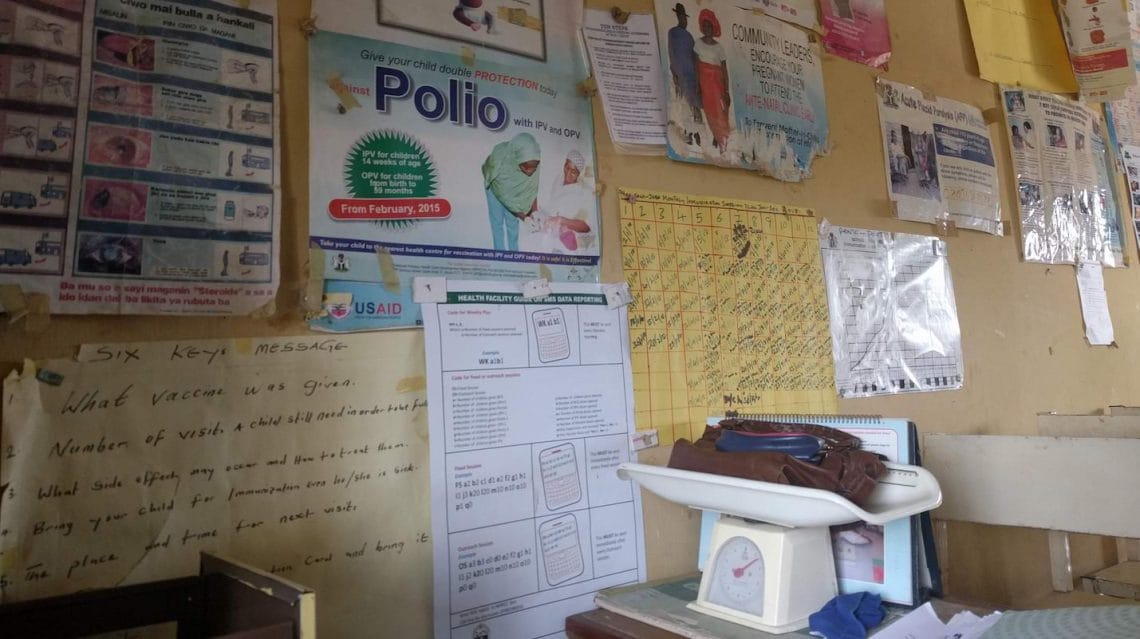
Providers typically have a number of tasks, job aids, and other materials competing for their attention.
“We don’t gamble with human life up here […] You know the main killer in Africa is this malaria.”
– Doctor, Akwa Ibom State, Nigeria
Most health care providers in Nigeria know the protocols for testing and treating patients for malaria. When asked, providers correctly explain that every case of fever should be tested, and that medication for malaria should only be prescribed to clients who test positive for malaria. But providers don’t always follow this protocol. Sometimes, they fail to test when they should. Often, they invest time, effort, and resources into administering the test, but still prescribe malaria medication even when test results come back negative. This behavior leads to wasted resources in the form of unnecessary prescriptions for malaria medication. It can also mean that providers fail to detect and treat other serious illnesses, such as pneumonia, that may present similar symptoms. Under the USAID-funded Breakthrough ACTION project, we sought to understand this seemingly counter-intuitive behavior and design solutions to improve compliance with the testing and treatment protocol.
When providers first see a patient, they must decide whether the patient needs a malaria test. However, in conversations with health care providers, we found that providers are generally primed to think of malaria when they see patients with a fever. For over 20 years, Nigeria has made a sustained effort to reduce the prevalence of malaria within its borders. Beginning with a National Malaria Control Policy in 1997, and through a series of strategic plans from 2001 through 2020, Nigeria has succeeded in raising awareness of malaria among health care providers and communities. While heightened sensitivity to a critical health issue is undoubtedly positive, one result of this is that many providers now assume that most patients with fever have malaria. If test results later contradict this assumption, providers reconcile the contradiction between the test results and their own assessment by discounting the reliability of the test. Consequently, providers don’t always follow negative test results.
To arrive at a robust solution, we looped back to our fact finding work about where and how providers do their jobs: in crowded, hectic health facilities where their attention is constantly stretched in many directions. In this environment, it was particularly important to look for a solution that didn’t ask providers to exert additional effort or pay special attention to engage with new materials. Providers typically have a number of tasks, job aids, and other materials competing for their attention. Reminders about proper testing protocol or more information about the reliability of tests would need to win this competition to have a chance of influencing provider behavior.
Moreover, behavioral science literature tells us that people generally have a strong preference for the status quo. If we asked providers to substantially change how they do their jobs or take on new tasks, we’d have to first overcome this resistance to change.
We designed a package of solutions to leverage these principles. One component of the package is a change to the patient flow in the clinic, by testing patients before consultation. Taking advantage of the fact that all patients’ vital signs are measured when they arrive at the clinic, patients with a fever or who report having had a fever in the past two days are now sent immediately for malaria testing before seeing a provider. This ensures that providers always see a malaria test result before they have a chance to make an assumption about the cause of the patient’s fever. It taps into people’s tendency to “anchor” or rely heavily on the first piece of information they see that relates to a decision they’re making.
This simple redesign derives immense strength from not expecting providers to consciously change how they usually do their work or asking any staff to add entirely new tasks to their job. A recently published study from Ghana found that a similar process change led to significant improvements in provider adherence to malaria testing guidelines. And in our own feasibility test, this solution was received very positively by providers and staff because it streamlined client flow. In combination with our other designs, it achieved positive trends in improving provider adherence to testing and treatment protocol, without placing additional burden on already overstretched healthcare providers.
To learn more about our approach and full intervention, view this brief or write to us at sriram@ideas42.org.


